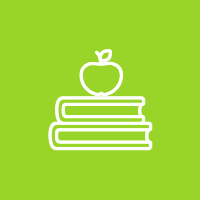Succession is a natural pattern of change that takes place over time in a forest or other ecosystem. Students read a story about succession and investigate the connections among plants, animals, and successional stages in a local ecosystem.
For the complete activity and more like this, purchase the Explore Your Environment: K-8 Activity Guide or the Nature of Fire activity collection at Shop.PLT.org and/or attend a professional development training in your state.
Below are some supporting resources for this activity.
STUDENT PAGES 
Download the copyright-free student pages that are included with this activity:
The Story of Mount St. Helens
(PDF)
Pictures of Succession
(PDF)
Tree Tops Valley
(PDF)
Spanish Student Page(s):
La historia del Monte St. Helens
(PDF)
Imágenes de Sucesión
(PDF)
El Valle de los Árboles
(PDF)
RECOMMENDED READING 
Expand your students’ learning and imaginations. Help students meet their reading goals, while building upon concepts learned in this activity, with the following children’s book recommendations:
ADDITIONAL RESOURCES 
The following tools and resources may be used to enhance the activity.
-
Tree Tops Valley Story
Tree Tops Valley – For a Grades 3-5 variation to this activity, read aloud a fictional story told from the perspective of siblings who observe forest changes over several decades. Stop after each part of the story and have students draw a picture of the successional stage in a journal. After reading, discuss the changes described in the story and shown in the drawings.
-
Video: Wildlife Habitat
“Wildlife Habitat.” This 7:42-minute video describes how the habitat requirements for different animals are diverse and ever-changing, and how most Great Lakes States vertebrate species require or prefer at least one forest type for part of their lifecycle. It is one of a series of BeLeaf It or Not! videos by Michigan State University Extension, which are geared for students.
-
Foldable 3-D Fire Triangle Model
Simply print out and then fold this 3-Dimensional fire triangle model to help teach the 3 elements of the fire triangle, as well as to show the important connections between weather and how it influences fire behavior.
-
Forest Restoration Following Wildfire
Learn about the Tree and Forest restoration process after a wildfire with this comprehensive resource from Montana State University (MSU) Extension Forestry. In addition, MSU Extension has compiled multiple other resources that help students understand implications of wildfires. Students can read a about a 13-Year Case Study of Fire in the Northern Rockies, use a photo guide to assess wildfire severity, or learn how to develop a fire hazard reduction plan.
-
Living with Wildlife: Snags
What is a snag? How do dead and dying trees benefit the ecosystem? Learn how dead trees can actually provide more habitats for wildlife than when they are alive with Snags—The Wildlife Tree, published by Washington state Department of Fish & Wildlife. The article highlights species that use snag trees to survive, what kinds of trees make the best snags, and how to create a snag tree for wildlife. For more species fact sheets and ways to attract wildlife to your yard, check out this Living with Wildlife series.
-
Climate Change around the World
An article in BBC News that discusses impacts of global warming in countries around the world and in major sectors of society: health, water, food, ecosystems, coasts, and industry.
-
Ring of Fire
WildFIRE PIRE is a project of the Montana State University, involving an international team of scientists putting the past, present, and future of wildfire into global perspective. The group will use thousands of years’ worth of historical data on landscape vegetation, fire, human behavior, and climate to build a computer simulation to understand how future changes in climate and human factors might affect vegetation patterns in global forests. To learn about their process and findings, you can read more here.
-
Fire Safety Website
Fire safety resources are available at www.firefacts.org. Teacher resources include a Jeopardy-style game on basic fire safety practices, fact sheets, family take-home activities, and links to additional fire safety resources and organizations. Student resources consist of online games and puzzles that teach fire safety rules.
-
Federal Registry for Educational Excellence – Fire Safety
Review fire safety practices with information and resources from the U.S. Fire Administration, the Federal Emergency Management Agency, and the Centers for Disease Control. You’ll find information about smoke alarms and fire extinguishers, kitchen safety, fire safety plans, and visits to a fire station. In addition, teachers can access online activities such as word searches, puzzles, and interactive quizzes that reinforce important fire safety messages.
-
Create Your Own Book App
Be the author, illustrator, and editor of your own literary adventure with Book Creator, an app that can be downloaded for the iPad from the iTunes store. Book Creator allows anyone to create and share their own journals, text books, children’s picture books and photobooks that can be designed with a multitude of text and image formatting options. This app offers a variety of printing and electronic sharing options that help its customers of all ages distribute their books to relatives, friends, and colleagues.
-
Digital Notebook Template
Want to go paperless in your classroom and experiment with digital note keeping? Read educator Nick Mitchell’s Scientific Teacher blog for ideas to transform the way you and your students take notes. This blog details using digital notebooks in the classroom, including basic information on why digital notebooks are useful and how to get started with free existing, provided templates.

